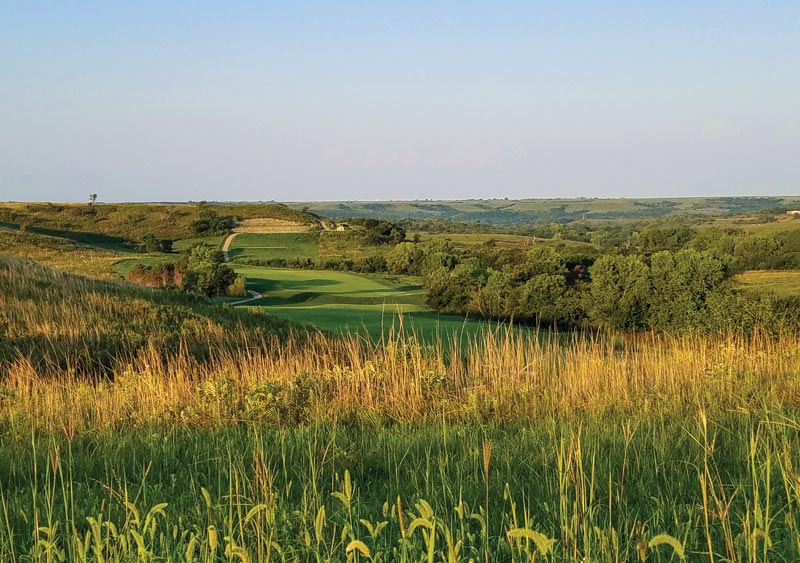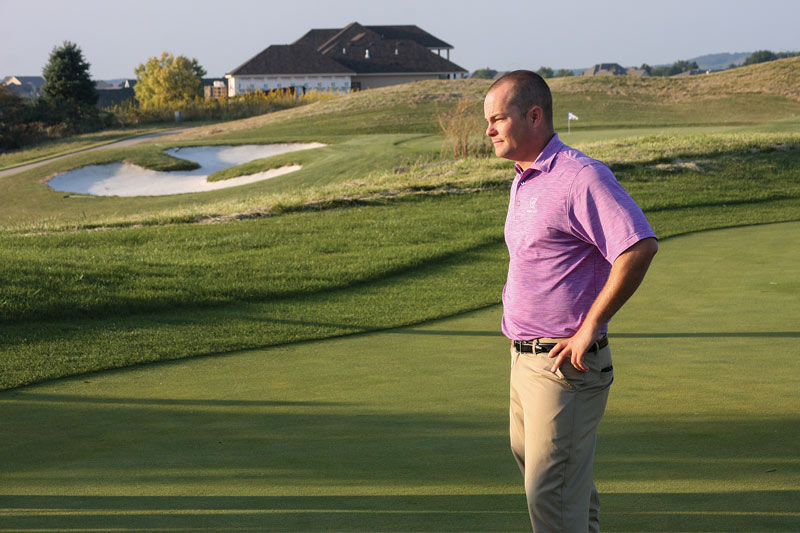
The native tallgrass prairie comes into play on every hole of Colbert Hills Golf Course in Manhattan, Kan. The course is home to the Kansas State University men’s and women’s golf teams. Photo by Matt Gourlay
Matt Gourlay, CGCS, MG, is the director of golf course operations at Colbert Hills Golf Course in Manhattan, Kan., a course built in the beautiful tallgrass prairie of the Flint Hills.
Gourlay has golf in his genetic makeup as a third-generation golf course superintendent, following in the footsteps of his father and grandfather. Go back further in his Scottish ancestry, and you find that one of his relatives married Old Tom Morris, and his family was involved in production of the “featherie” golf ball — a ball with a leather cover stuffed with goose feathers. In fact, the ball was commonly known as the “Gourlay” and was used throughout the first half of the 19th century in Scotland.
Gourlay’s inherent love of the game has contributed to his success, as has the fact that he is hardworking, innovative and intelligent, and doesn’t hesitate to think outside the box.
The 16-year GCSAA member oversees a championship golf course with a minimal budget. His ability to maintain quality with less inputs is visible through the entire course, but he’s recently received attention for his approach to managing the creeping bentgrass putting greens. Earlier this year, he won the Innovative Conservation Award in the GCSAA/Golf Digest Environmental Leaders in Golf Awards program for the unique management strategies he employs.
The greens rarely see an aerifier, receive very little fertilization, and are mowed once or twice weekly, and when they are mowed, there’s no bucket on the mower. That’s right: Buckets aren’t on Gourlay’s list.
Colbert Hills opened for play in 2000, and the greens were built to USGA specifications. In Gourlay’s opinion, the high sand component of the greens allows them to be managed with little or no aerification, because compaction is minimal and infiltration rates are high.
Furthermore, Colbert Hills is a destination public golf course. A large percentage of golfers travel from over 50 miles away to play. Golfers don’t appreciate traveling a long distance only to find, when they reach the first green, that the greens have been aerified.
The greens at Colbert Hills are relatively large — they average over 7,500 square feet — which is fortunate for Gourlay, because that allows foot traffic to be spread out across the surface with changes in hole locations. Gourlay uses frequent sand topdressing to manage organic matter accumulation and monitors greens’ status using laboratory testing. That said, organic matter accumulation is relatively slow, because he’s able to keep nitrogen levels quite low (in 2018, he applied a total of 0.5 pound of nitrogen in five separate applications). For other nutrients, he follows the Minimum Level for Sustainable Nutrition guidelines and has found that he can go well below those numbers and still maintain a quality surface.

Matt Gourlay, CGCS, MG, has led golf course maintenance at Colbert Hills since 2007. Photo by Scott Hollister
Gourlay also takes advantage of a perched water table provided by well-constructed greens, which allows him to irrigate deeply and less frequently — every five to seven days, on average. These management strategies enable him to keep the turf healthy without encouraging excessive vegetative growth. Ultimately, this also keeps mowing to a minimum. In fact, in 2018, Gourlay reduced mowing requirements on greens by 600 labor hours.
Gourlay mows greens about 50 to 60 times each growing season, which spans a period of about 30 to 31 weeks in eastern Kansas, and he uses a roller about 120 times to maintain firmness. By removing the buckets from the mowers, he returns about the same amount of nitrogen back to the greens as he applies. Clippings are so limited that they don’t disturb golf ball roll, and as Gourlay puts it, “Buckets don’t catch all clippings anyway, and many fall to the putting surface even when one tries to collect them.”
The 20-year-old greens at Colbert Hills have no annual bluegrass (Poa annua) in them. How many others in the central U.S. can say they have greens that have been in place for 20 years and contain no Poa? The aforementioned management strategies have obviously contributed to this.
Some may consider Gourlay’s turf management approach extreme, but he has shifted cultural practices over time to match the resources he has available. Instead of hanging his head and complaining that a flat or declining budget won’t allow for surfaces to be maintained at a desired level, he has embraced the challenge and done what was needed to maintain quality turf. We can all take something from the innovative ideas Gourlay has applied.
Jack Fry, Ph.D., is a professor of turfgrass science at Kansas State University, currently working at the school’s Research and Extension Center in Olathe, Kan. He is a 22-year educator member of GCSAA.